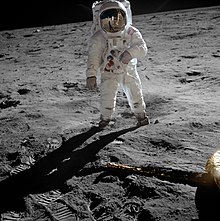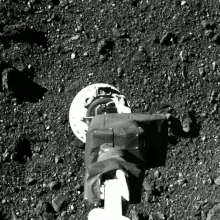

— (Full-sized image)
A planetary surface is where the solid or liquid material of certain types of astronomical objects contacts the atmosphere or outer space. Planetary surfaces are found on solid objects of planetary mass, including terrestrial planets (including Earth), dwarf planets, natural satellites, planetesimals and many other small Solar System bodies (SSSBs).[1][2][3] The study of planetary surfaces is a field of planetary geology known as surface geology, but also a focus on a number of fields including planetary cartography, topography, geomorphology, atmospheric sciences, and astronomy. Land (or ground) is the term given to non-liquid planetary surfaces. The term landing is used to describe the collision of an object with a planetary surface and is usually at a velocity in which the object can remain intact and remain attached.
In differentiated bodies, the surface is where the crust meets the planetary boundary layer. Anything below this is regarded as being sub-surface or sub-marine. Most bodies more massive than super-Earths, including stars and giant planets, as well as smaller gas dwarfs, transition contiguously between phases, including gas, liquid, and solid. As such, they are generally regarded as lacking surfaces.
Planetary surfaces and surface life are of particular interest to humans as it is the primary habitat of the species, which has evolved to move over land and breathe air. Human space exploration and space colonization therefore focuses heavily on them. Humans have only directly explored the surface of Earth and the Moon. The vast distances and complexities of space makes direct exploration of even near-Earth objects dangerous and expensive. As such, all other exploration has been indirect via space probes.
Indirect observations by flyby or orbit currently provide insufficient information to confirm the composition and properties of planetary surfaces. Much of what is known is from the use of techniques such as astronomical spectroscopy and sample return. Lander spacecraft have explored the surfaces of planets Mars and Venus. Mars is the only other planet to have had its surface explored by a mobile surface probe (rover). Titan is the only non-planetary object of planetary mass to have been explored by lander. Landers have explored several smaller bodies including 433 Eros (2001), 25143 Itokawa (2005), Tempel 1 (2005), 67P/Churyumov–Gerasimenko (2014), 162173 Ryugu (2018) and 101955 Bennu (2020). Surface samples have been collected from the Moon (returned 1969), 25143 Itokawa (returned 2010), 162173 Ryugu and 101955 Bennu.
- ^ Meyer, Charles; Treiman, Allan H.; Kostiuk, Theodor, eds. (May 12–13, 1995). Planetary Surface Instruments Workshop (PDF). Houston, Texas: Lunar and Planetary Institute. p. 3. Bibcode:1996psi..work.....M. Retrieved 2012-02-10.
- ^ "Planetary Surface Materials Haskin Research Group". Department of Earth and Planetary Sciences | Washington University in St. Louis. Archived from the original on Mar 10, 2014. Retrieved 2012-02-10.
- ^ Melosh, Jay (August 2007). Planetary Surface Processes. Cambridge Planetary Science. p. 9. ISBN 978-0-521-51418-7.